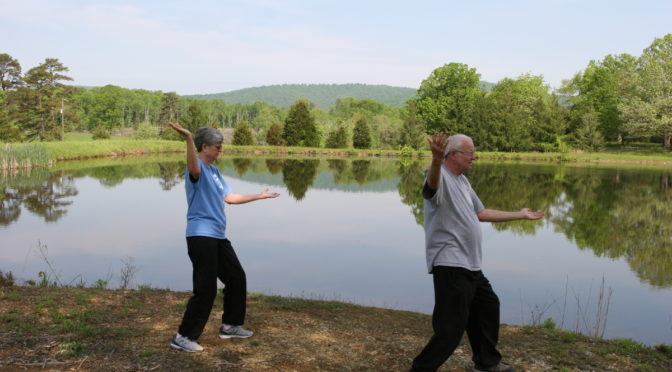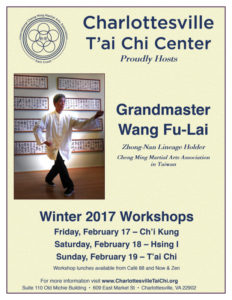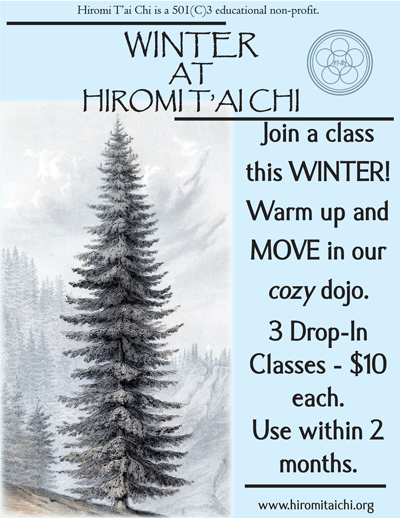For the past seventeen months Ed and I have been students of Master Hiromi Johnson, Director of the Charlottesville T’ai Chi Center. We are learning the Cheng Ming form of T’ai Chi Chuan which we started in our late sixties. In the following article, Ed as a former physician of Internal Medicine focuses on the health benefits of T’ai Chi as well as other aspects of our shared learning experience. My focus, with a background in Recreation and Park Management, is on my personal experience and how I feel T’ai Chi is beneficial to growing older.
 Ed:
Ed:
At the beginning of each class we do a series of warmup exercises to loosen and stretch our muscles. This has improved our flexibility. Each member of the class sets their own limit on the extent of their warmup, so there should be no major pain or injuries. These exercises gently work the upper and lower back muscles, shoulders, hips, and thighs. This is followed by two sequences of specific T’ai Chi exercises which consist of movements that we perform throughout the formal 100-step T’ai Chi form. These exercises have more martial applications, but are mainly demonstrations for learning the proper form for positioning and moving our body when we start the formal T’ai Chi sequence.
Once we learned the gross movements and positions, we gradually started refining the details of each step. Only as we began the refinement process did we realize that a minimum error in our form would result in a major loss of strength and force. When we finish our warmups and the T’ai Chi Exercises, we do a T’ai Chi standing meditation. This helps to relax and calm our minds before we begin the 100-steps. The effects of this relaxing meditation persist for the rest of the day.
When we first see a new movement it is very confusing, and I think it will be impossible to remember, but by carefully observing our instructor as she moves gracefully through the process of each step, I learn the individual components of the movements.
The key to the enjoyment of T’ai Chi is to commit yourself to the process of concentrating on the information in class, taking it home, and practicing each day until your next class. At first we had only one movement to practice, so it didn’t take very long. As we learned a new movement, we would focus on it, and add it to the preceding one. The most important movements are the first fourteen because subsequent steps are built on these steps as you go further into the form. These fourteen movements improved my strength, especially in the legs and back. The increased strength and flexibility helped improve my balance.
Additional benefits we personally discovered as we progressed in T’ai Chi were weight loss, mental calming, better posture, increased flexibility and decreased pain from sites of prior injuries. Additional benefits suggested in The Harvard Medical School Guide to T’ai Chi written by Peter Wayne and Mark Fuerst include: fall prevention, lowered systolic and diastolic blood pressure, reduced back pain, reduced stress, improved psychological well-being, and improved breathing efficiency. There was also improvement in diabetes mellitus, fibromyalgia, rheumatoid arthritis, osteoporosis, coronary artery disease, stroke and cholesterol levels in some patients. Most of the patients who benefited were enrolled in a twelve week program of beginning T’ai Chi. These patients with regular daily practice completed the first fourteen steps of the program by the end of the twelve weeks.
Betsy:
First of all T’ai Chi with its gentle movements is a wonderful way to exercise, especially at our stage of life. We both have had previous injuries from other forms of exercise and T’ai Chi enables us to exercise without injuring our bodies. Although I am not a natural student of Tai Chi, and I lack flexibility, Hiromi encourages me to progress within my capabilities and my limitations. Her encouraging words, “Inch by inch many things are possible” point me in a positive direction.
Initially I was drawn to T’ai Chi to help reduce my stress levels and to experience its many health benefits. Now I practice daily for many other reasons. To me practicing the Cheng Ming style with its various nuances and subtleties is like learning to solve a moving puzzle. My brain seems to want to try to fit the pieces together. This is a surprise to me because focusing is not a natural habit of mine. .
I am learning new forms, repeating some forms, learning variations of forms, and continually learning to place the forms in a sequence of moves. All of this challenges my ability to not only learn but to remember. My brain gets a good workout in addition to my body. I also appreciate that Tai Chi helps me to become more spatially aware of my body when I place my feet, knees, hands, elbows, shoulders, and hips in various positions. This is important for many reasons including learning how to keep a better sense of balance as I travel through my daily activities.
The principles of T’ai Chi such as alignment, harmony, awareness, intention, relaxation, centering, the integration of opposites, and living in the present moment all appeal to me. In addition to our forms, each of our warm up exercises has health benefits as well. My instruction in how to break down complicated tasks into manageable steps, how to persevere when I struggle with a form or forms (in my case this is often!), how to become more patient, and how to learn to just “Be with what is” (Hiromi’s sage advice) can carry over to my daily life. The wide variety of learning opportunities through classes, lessons and workshops is another motivating factor.
T’ai Chi has introduced me to many wonderful kind, positive, and encouraging people. Practicing T’ai Chi with my husband Ed has given me an opportunity to share something with him that we enjoy so much. Having three young grandchildren, and feeling I am doing something that will help me engage with them in an active way, is priceless. Finally, the joy of practicing T’ai Chi is very important to me. I cannot express it well in words, but there are times something opens inside me when I practice T’ai Chi creating a space for possibilities. At my age I am well aware of my limitations, and it is such a good feeling when I become aware of these possibilities.
Ed and I appreciate our opportunity to learn T’ai Chi from our teachers who have encouraged us each step of the way, and we especially want to express our deep gratitude to Master Hiromi Johnson and Grand Master Wang Fu-Lai.




 Amazon will now make donations to CTCC each time you shop through their AmazonSmile program! If you shop on Amazon, you can support CTCC!
Amazon will now make donations to CTCC each time you shop through their AmazonSmile program! If you shop on Amazon, you can support CTCC!